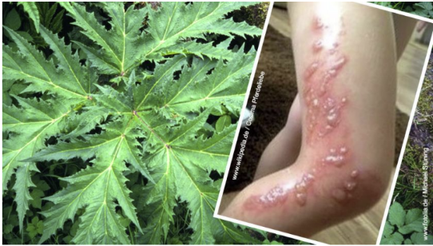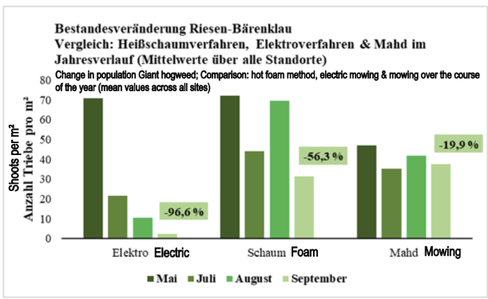Using Electricity to Manage Giant Hogweed
Invasive plants such as Giant Hogweed have previously been difficult to treat without chemicals. Now we have proven solutions using electricity, which can be just as effective as herbicides.
Giant hogweed - An invasive plant that requires management

• Lifespan: 2 years
• Growth height: Up to 4 meters (growth up to 1 meter by mid-May)
• Flower: 50-70 cm in diameter with up to 60,000 seeds per flower, which can persist in the soil for up to 7 years
• Spreading: Mass spread via seeds
• Competitive power: Extremely high. Due to its above-average large leaf surfaces, it shades its entire surroundings, which is why the growth of other (native) plants is very strongly inhibited
Caution, poisonous!
• All parts of the plant (leaves, stems, etc.) contain phototoxic furanocoumarins which, when touched and exposed to sunlight, can cause severe skin inflammation with severe blistering in humans and animals within a short period of time. = 3rd degree burns. Risk of blindness if the stem sap comes into contact with the eyes.
• Due to their toxicity, these plants may currently only be removed in full-body protective suits
Treating Giant Hogweed with Electricity
The New Electric Weedkiller from Kersten is a perfect tool for managing Giant Hogweed, as it will boil the storage root - depriving the plant of nutrients.
The treatment can be effectively delivered with the weeding lance.

The principle -
The system is based on electrophysical technology. The device generates a very high current pulse at the touch of a button, thereby eliminating unwanted plants in a targeted manner. The power module supplies the high voltage required for this, this current flows via the hand lance into the plant and then into the substrate. The circuit is closed again via the current feedback earth spike, which is inserted into the soil via another cable. The energy boils the water inside the plant and thus destroys the plant structure.
The result:
• The plant‘s chlorophyll is immediately damaged, the cells are irreversibly destroyed and die
• The water supply to the cells is interrupted
• The plant dries out
The right amount of energy and optimized ground contact are decisive for the effect: Plants with a high water content and, compared to their leaf mass, with few stems and roots require little energy and are easy to treat. Very dense and woody wild herbs or very large plants require a lot of energy. In these cases, methods combined with mowing, for example, achieve the best results, as the young new shoots carry a particularly large amount of water and therefore direct the flow even better into the plant. Plants with larger rootstocks or rhizomes are severely weakened and sometimes have to be treated several times before they are completely destroyed.
Below are the results of a trial with 4 applications between May and September using several different methods. The trial was conducted by BOKU University of Natural Resources and Life Sciences in Vienna.
Electrocution of Giant Hogweed had the greatest effect at reducing the population out of any of the methods used, dramatically reducing the populations within just a few months. The Electric Weedkiller resulted in the greatest reduction in shoots/m2 (-96.6 %), particularly in LA
foliage (137 vs. 4 shoots/m2 at the end of the season)

For more information on the Kersten Electric Weedkiller click here!
No comments yet. Login to start a new discussion Start a new discussion